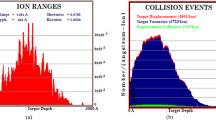Abstract
Using the Mössbauer spectroscopy method for the 119Sn isotope the state of tin impurity atoms in crystalline c-Si and amorphous a-Si silicon is studied. If tin concentration in c-Si does not exceed 2 × 1019 atoms/cm3 then tin enters the lattice as substitutional impurity forming sp 3 hybrid system of chemical bonds. There is discussed a model that describes tin impurity atom as an isotopic impurity. If tin concentration in c-Si exceeds the value, associates of tin impurity atoms are formed in the structure of the doped semiconductor. There are studied the electrical and optical properties of tin doped films of thermally spray-coated amorphous silicon. It is shown that in contrast to the crystalline silicon where tin is an electrically inactive substitution impurity, in vacuum deposited amorphous silicon it produces an acceptor band near the valence band and a fraction of the tin atoms becomes charged.
Similar content being viewed by others
References
The Physics of Hydrogenated Amorphous Silicon, Joannopouls, J.D. and Lucovsky, G., Eds., Berlin: Springer-Verlag, 1984.
Bordovsky, G., Marchenko, A., and Seregin, P., Mössbauer of Negative U Centers in Semiconductors and Superconductors: Identification, Properties, and Application, Berlin: LAP Lambert Academic, 2012.
Masterov, V.F., Nasredinov, F.S., Seregin, P.P., Terukov, E.I., and Mezdrogina, M.M., Erbium impurity atoms in silicon, Semiconductors, 1998, vol. 37, no. 6, pp. 636–639.
Bordovskii, G.A., Castro, R.A., Seregin, P.P., and Dobrodub, A.A., Properties and structure of (As2Se3)1 − z (SnSe) z − x (GeSe)x and (As2Se3)1 − z (SnSe2) z − x (GeSe2)x glasses, Glass Phys. Chem., 2006, vol. 32, no. 3, pp. 320–324.
Bordovskii, G.A., Castro, R.A., Marchenko, A.V., and Seregin, P.P., Radiation stability of tin charge states in the (As2Se3)1 − z (SnSe) z − x (GeSe)x glasses, Glass Phys. Chem., 2007, vol. 33, no. 5, pp. 471–474.
Bordovskii, G.A., Marchenko, A.V., and Seregin, P.P., The influence of amorphization on the local environment of atoms in arsenic chalcogenides, Glass Phys. Chem., 2008, vol. 34, no. 5, pp. 543–546.
Bordovsky, V.A., Anisimova, N.I., Marchenko, A.V., and Seregin, P.P., Influence of irradiation on the local environment of chalcogen atoms in vitreous films of the As-S, As-Se, and As-S-Se systems, Glass Phys. Chem., 2008, vol. 34, no. 5, pp. 28–31.
Bordovskii, G.A., Dzemidko, I.A., Marchenko, A.V., and Seregin, P.P., Structure and physicochemical properties of glasses in the (As2Se3)1 − z (SnSe2)z − x(Tl2Se)x and (As2Se3)1 − z (SnSe) z − x (Tl2Se)x systems, Glass Phys. Chem., 2009, vol. 35, no. 4, pp. 364–368.
Boltaks, B.I., Diffusiya i tochechnye defekty v poluprovodnikakh (Diffusion and Point Defects in Semiconductors), Leningrad: Nauka, 1972.
Author information
Authors and Affiliations
Corresponding author
Additional information
The article is published in the original.
Rights and permissions
About this article
Cite this article
Marchenko, A., Anisimova, N., Naletko, A. et al. A study of tin impurities in crystalline and amorphous silicon by means of Mössbauer spectroscopy. Glass Phys Chem 39, 287–293 (2013). https://doi.org/10.1134/S1087659613030127
Received:
Published:
Issue Date:
DOI: https://doi.org/10.1134/S1087659613030127




